Snow White
| Snow White | |
|---|---|
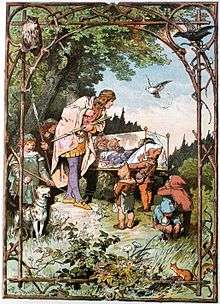 Schneewittchen by Alexander Zick | |
| Folk tale | |
| Name | Snow White |
| Data | |
| Aarne-Thompson grouping | 709 |
| Country | Germany |
"Snow White" is a 19th-century German fairy tale which is today known widely across the Western world. The Brothers Grimm published it in 1812 in the first edition of their collection Grimms' Fairy Tales. It was titled in German: Sneewittchen (in modern orthography Schneewittchen) and numbered as Tale 53. The name Sneewittchen was Low German and in the first version it was translated with Schneeweißchen. The Grimms completed their final revision of the story in 1854.[1][2]
The fairy tale features such elements as the magic mirror, the poisoned apple, the glass coffin, and the characters of the evil queen and the Seven Dwarfs. The seven dwarfs were first given individual names in the 1912 Broadway play Snow White and the Seven Dwarfs and then given different names in Walt Disney's 1937 film Snow White and the Seven Dwarfs. The Grimm story, which is commonly referred to as "Snow White",[3] should not be confused with the story of "Snow-White and Rose-Red" (in German "Schneeweißchen und Rosenrot"), another fairy tale collected by the Brothers Grimm.
In the Aarne–Thompson folklore classification, tales of this kind are grouped together as type 709, Snow White. Others of this kind include "Bella Venezia", "Myrsina", "Nourie Hadig", "Gold-Tree and Silver-Tree",[4] "The Young Slave" and "La petite Toute-Belle".
Plot
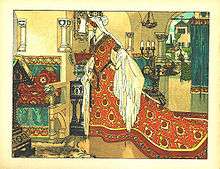
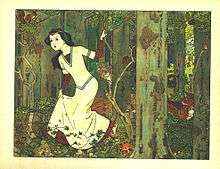
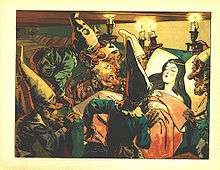
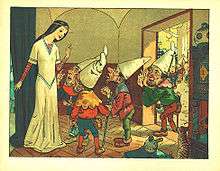
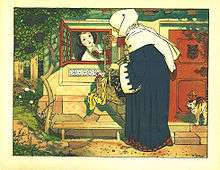
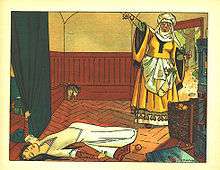
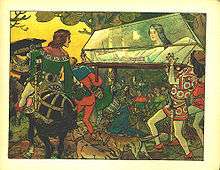
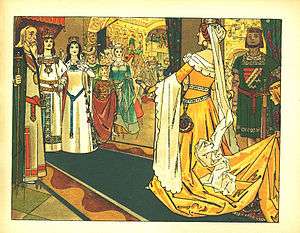
At the beginning of the story, a queen sits sewing at an open window during a winter snowfall when she pricks her finger with her needle, causing three drops of red blood to drip onto the freshly fallen white snow on the black windowsill. Then, she says to herself, "How I wish that I had a daughter that had skin as white as snow, lips as red as blood, and hair as black as ebony." Some time later, the queen gives birth to a baby daughter whom she names Snow White, but the queen dies a short while later.[1][5]
A year later, Snow White's father, the king, marries again. His new wife is very beautiful, but she is a vain and wicked woman. The new queen possesses a magic mirror, which she asks every morning, "Magic mirror on the wall, who is the fairest one of all?" The mirror always tells the queen that she is the fairest. The queen is always pleased with that, because the magic mirror never lies. But as Snow White grows up, she becomes more beautiful each day and even more beautiful than her stepmother. When the queen asks her mirror, it tells her that Snow White is the fairest.[1][5]
This gives the queen a great shock. She becomes envious, and from that moment on, her heart turns against Snow White, whom the queen grows to hate increasingly with time. Eventually, the angry queen orders a huntsman to take Snow White into the forest to be killed. As proof that Snow White is dead, the queen demands that he returns with her heart. The huntsman takes Snow White into the forest. After raising his knife, he finds himself unable to kill her when Snow White finds out about her stepmother's plan. The huntsman spares Snow White and lets her go, bringing the queen the heart of a wild animal instead.[1][5]
After wandering through the forest, Snow White discovers a tiny cottage belonging to a group of seven dwarfs. Since no one is at home, she eats some of the tiny meals, drinks some of their wine, and then tests all the beds. Finally, the last bed is comfortable enough for her and she falls asleep. When the dwarfs return home, they immediately become aware that someone had been in their house, because everything in their home is in disorder. They head upstairs and discover the sleeping Snow White. She wakes up and explains to them what happened, and the dwarfs take pity on her and let her stay with them in exchange for housekeeping. They warn her to be careful when alone at home and to let no one in when they are working in the mountains.[1][5]
Meanwhile, the queen, believing that Snow White is dead, asks her mirror once again: "Magic mirror on the wall, who is the fairest one of all?" The mirror tells her that Snow White is the still the fairest in the land.[1] The queen is furious when she learns that Snow White is still alive and decides to kill the girl herself. Disguised as an old peddler, the queen appears at the dwarfs' cottage and offers Snow White colorful, silky laced bodices as a present. Then the queen laces her up so tightly that Snow White faints. But the dwarfs return just in time, and Snow White revives when the dwarfs loosen the laces.[1][5]
The queen then consults her magic mirror again, and it tells her that Snow White is still the fairest. The queen dresses as a comb seller and convinces Snow White to take a beautiful comb as a present. She brushes Snow White's hair with the poisoned comb and the girl faints again. She is again revived by the dwarfs when they remove the comb from her hair. When the mirror again indicates that Snow White still lives, the queen makes a fourth and final attempt on Snow White by disguising herself as a poor woman, offering a poisoned apple to her. At first Snow White is hesitant to accept it, so the queen cuts the apple in half, eating the white (harmless) half and giving the red poisoned half to Snow White. The girl eagerly takes a bite and falls into a state of suspended animation, causing the Queen to triumph. This time, the dwarfs are unable to revive Snow White. Assuming that she is dead, they place her in a glass casket.[1][5]
Some time later, a prince stumbles upon Snow White lying in her glass coffin and instantly falls in love with her. The seven dwarfs succumb to his entreaties to let him have Snow White. The moment he lifts the coffin to carry it away to her proper resting place, one of the servants trips and loses his balance. This caused the piece of poisoned apple to dislodge from Snow White's throat, reviving her. Enchanted by Snow White's beauty, the Prince declares his love for her. Snow White and the prince invite everyone to come to their wedding party, including Snow White's stepmother.
Meanwhile, the queen, still believing that Snow White is dead, again asks her magic mirror who is the fairest in the land. The mirror says that the Prince's bride is the fairest. Not knowing that the Prince's bride is her stepdaughter, the queen arrives at the wedding and is shocked to find that the bride is Snow White. She is frozen with rage and fear, but when the Queen was about to start a pandemonium, the prince, who recognizes her as a threat to his kingdom, orders for her to wear a pair of red-hot iron slippers and dance in them until she drops dead for the attempted murder of Snow White, so that the wedding will peacefully continue.
Inspiration
Many scholars have theorized about the possible origins of the tale. In 1994, a German historian named Eckhard Sander published Schneewittchen: Märchen oder Wahrheit? (Snow White: Fairy Tale or Truth?), claiming he had uncovered an account that may have inspired the story that first appeared in Grimm’s Fairy Tales. According to Sander, the character of Snow White was based on the life of Margaretha von Waldeck, a German countess born to Philip IV in 1533. At the age of 16, Margarete was forced by her stepmother, Katharina of Hatzfeld, to move away to Brussels. There, Margarete fell in love with a prince who would later become Philip II of Spain. Margarete’s father and stepmother disapproved of the relationship as it was ‘politically inconvenient’. Margarete mysteriously died at the age of 21, apparently having been poisoned. Historical accounts point to the King of Spain, who opposing the romance, may have dispatched Spanish agents to murder Margarete.[6]
Scholar Graham Anderson compares the story of Snow White to the Roman legend of Chione, recorded in Ovid's Metamorphoses. The name Chione means "Snow" in Greek and, in the story, she is described as the most beautiful woman in the land, so beautiful that the gods Apollo and Mercury both fell in love with her. Mercury put her to sleep with the touch of his caduceus and raped her in her sleep. Then Apollo, disguised as an old crone, approached her and raped her again. These affections led Chione to openly boast that she was more beautiful than the goddess Diana herself, resulting in Diana shooting her through the tongue with an arrow.[7][8]
Karlheinz Bartels, a pharmacist and scholar from Lohr am Main, a town in northwestern Bavaria, found evidence that Snow White was Maria Sophia Margarethe Catharina, Baroness von und zu Erthal, who was born in Lohr on June 25, 1725.[9][10] Her father, Philipp Christoph von und zu Erthal, was the local representative of the Prince Elector of Mainz.[11] After the death of Maria Sophia’s birth mother in 1738, her father remarried in 1743. The stepmother, Claudia Elisabeth von Reichenstein, was domineering and employed her new position to the advantage of her children from her first marriage. A magic mirror referred to as “The Talking Mirror”, known as always telling the truth, can still be viewed today in the Spessart Museum in the Lohr Castle, where Maria Sophia’s stepmother lived. This mirror was presumably a present from Maria Sophia’s father to his second wife. It was a product of the Lohr Mirror Manufacture (Kurmainzische Spiegelmanufaktur).[12]
Variations
The principal studies of traditional Snow White variants are Ernst Böklen's, Schneewittchenstudien of 1910, which (re)prints fifty Snow White variants,[13] and studies by Steven Swann Jones.[14]
In their first edition, the Brothers Grimm published the version they had first collected, in which the villain of the piece is Snow White's jealous biological mother. In a version sent to another folklorist prior to the first edition, additionally, she does not order a servant to take her to the woods, but takes her there herself to gather flowers and abandons her; in the first edition, this task was transferred to a servant.[15] It is believed that the change to a stepmother in later editions was to tone down the story for children.[16]
One version of Snow White is the 1937 American animated film Snow White and the Seven Dwarfs by Walt Disney. Disney's variation of Snow White gave the dwarfs names and included a singing Snow White. Instead of her lungs and liver, as written in the original, the huntsman is asked by the queen to bring back Snow White’s heart. While the heart is mentioned, it is never shown in the box. Snow White is much more mature (about 14). And she is discovered by the dwarfs after cleaning the house, not vandalizing it. Furthermore, in the Disney movie the evil queen tries only once to kill Snow White (by a poisoned apple) and fails (this was likely to save time). She then dies by falling down a cliff and being crushed by a boulder, after the dwarfs had chased her through the forest. In the original, the queen is forced to dance to death.[17]
In Snow White (1987), produced by Cannon Movie Tales, the Evil Queen, after being informed for the last time that Snow White is alive and the most fair, is consumed with rage and hurls an object at the mirror causing it to crack. As she travels to the wedding, the Evil Queen begins to age rapidly as the mirror continues to crack. By the time she reaches the wedding and bursts in, she is an old hag and is humiliated by the crowd. She leaves and, simultaneously with the mirror in her castle, disintegrates into a pile of dust while Snow White and the Prince are married.
In the 2012 adaptation Snow White and the Huntsman, directed by Rupert Sanders, Snow White becomes a warrior in order to overthrow the Evil Queen named Ravenna, and the huntsman named Eric is presented as her mentor and possible love interest.
The movie Mirror Mirror (film) has the queen (Julia Roberts) surviving, but she is hopelessly haggard when she attends Snow White (Lily Collins)’s wedding.
The 2007 Disney movie Enchanted (film) features a character named Giselle (Amy Adams) who is loosely based on Snow White (poisoned apple), Sleeping Beauty (fighting a dragon), and Cinderella (losing a shoe at a dance). The prince’s stepmother Narissa (Susan Sarandon) poisons Giselle at a dance. Giselle recovers and later fights Narissa, who has transformed into a dragon. Giselle’s chipmunk friend Pip (Jeff Bennett) sends Narissa falling to her death during the fight. Giselle later falls in love with 6-year-old Morgan’s father and decides to live with them, whereas Morgan’s former stepmom-to-be Nancy moves to Giselle’s hometown and marries the prince.
In 2013, a version of Mattel schools of fairy tale characters, Ever After High, Snow White has a daughter, Apple White (Royal), who disputes with Raven Queen (daughter of the Evil Queen and Rebel) who prefers the Rebels follow the heart, writing their own way. Raven is the leader of the Rebels, a group of students who want to choose their own storybook endings, whom decides to be kind after being horrified by her mother’s cruelty and witnessing a possible dark future for herself during Legacy Day. This led to Raven refusing to follow her evil destiny and declaring herself good, much to Apple’s disappointment. The Royals believe that their stories should be followed, lest they end in disaster. It’s up to Raven and her friends to convince Apple and the Royals that their destinies will be fine.
Many later versions omit the Queen's attempted cannibalism, eating what she believed to be the lungs and liver of Snow White. This may be a reference to old Slavic mythology which includes tales of witches eating human hearts.
Descendants (2015 film) character Evie is the cheerful yet flirtatious daughter of the Evil Queen.
From other traditions
Many other variations of the story exist across and outside Europe. In some of these variations the dwarfs are robbers, while the magic mirror is a dialog with the sun or moon.
- In a version from Albania, collected by Johann Georg von Hahn,[18] the main character lives with 40 dragons, and her sleep is caused by a ring. The beginning of the story has a twist, in that a teacher urges the heroine to kill her evil stepmother so that she would take her place. The origin of this tale is debated; it is likely no older than the Middle Ages. In fact, there are possibly two Albanian versions of Snow White: one in which her stepmother tries to kill her, and another in which her two jealous sisters try to kill her.
- "The Jealous Sisters" is another Albanian fairy tale. In both fairy tales the death is caused by a ring.[19]
- Bidasari is a Malay tale written around 1750 A.D which tells the story of a witch queen who asks her magic mirror about the prettiest lady in the kingdom.
- In parallel to the stepmother's question of her magic mirror, the Indian epic poem Padmavat (1540) includes the line: "Who is more beautiful, I or Padmavati?, Queen Nagamati asks her new parrot, and it gives a displeasing reply...";
- Nourie Hadag from Armenia was the daughter of a woman who asked the Moon, "Who is the most beautiful in the world?", and the response is always "Nourie Hadag". The mother plots to kill her daughter.[20][21]
- The story in Russian writer Alexander Pushkin's poem The Tale of the Dead Princess and the Seven Knights (1833) is similar to that of Snow White, with knights replacing dwarfs.[22]
In film
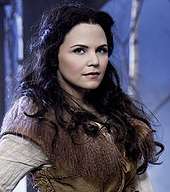
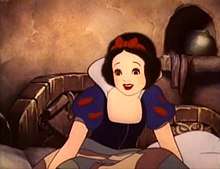
- Snow White (1916), a silent film by Famous Players-Lasky produced by Adolph Zukor and Daniel Frohman, directed by J. Searle Dawley, and starring Marguerite Clark, Creighton Hale, and Dorothy Cumming.
- Snow-White (1933), also known as Betty Boop in Snow-White, a film in the Betty Boop series from Max Fleischer's Fleischer Studios.
- Snow White and the Seven Dwarfs (1937), an animated Disney film based on the fairy tale.
- Snow White and the Huntsman (2012), starring Kristen Stewart, Charlize Theron, Chris Hemsworth, and Sam Claflin.
- Mirror Mirror (2012), starring Julia Roberts as the Evil Queen Clementianna,[23] Lily Collins as Snow White, Armie Hammer as Prince Andrew Alcott, and Nathan Lane as Brighton, the Queen's majordomo.[24]
- I sette nani alla riscossa (The Seven Dwarfs to the Rescue) (1951), an Italian film based on the fairy tale.
- Schneewittchen und die sieben Zwerge (1955), a German live-action adaptation of the fairy tale.
- Snow White (1987), starring Diana Rigg as the Evil Queen and Nicola Stapleton and Sarah Patterson both as Snow White.
- Amada Anime Series: Super Mario Bros. (1989), a three-part OVA series featuring Mario characters in different fairy tales.
- Schneewittchen und das Geheimnis der Zwerge (1992), a German adaptation of the fairy tale.
- Snow White: A Tale of Terror (1997), starring Sam Neill as Snow White's father, Sigourney Weaver as the Evil Queen, and Monica Keena as Snow White.
- Snow White: The Fairest of Them All (2001), starring Kristin Kreuk as Snow White and Miranda Richardson as Queen Elspeth.
- The Brothers Grimm (2005), an adventure fantasy film directed by Terry Gilliam and starring Matt Damon, Heath Ledger, and Lena Headey.
- Schneewittchen (2009), a German made-for-television film starring Laura Berlin as Snow White.
- Pamuk Prenses ve 7 Cüceler (1970), a Turkish live-action remake of the 1937 Disney film.
- The Huntsman: Winter's War (2016), which features Snow White as a minor character.
- Blancanieves (2012), a silent Spanish film based on the fairy tale.
- Grimm's Snow White (2012), starring Eliza Bennett as Snow White and Jane March as the Evil Queen Gwendolyn.
- Charming (2015), an animated film featuring Snow White as one of the princesses, featuring the voice of Avril Lavigne.
- Snow White (1961), an East German fairy tale film directed by Gottfried Kolditz.
In television
- Faerie Tale Theatre (1984) has an episode based on the fairy tale starring Vanessa Redgrave as the Evil Queen, Elizabeth McGovern as Snow White, and Vincent Price as the Magic Mirror.
- The 10th Kingdom (2000) is a TV miniseries featuring Snow White as a major character.
- Once Upon A Time (2011) is a TV series featuring Snow White, Prince Charming, their daughter Emma Swan, and the Evil Queen as the main characters.
In literature
- Snow White (1967), a postmodern novel by Donald Barthelme which describes the lives of Snow White and the dwarfs.
- Snow White and the Seven Dwarfs (1971), a poem by Anne Sexton in her collection Transformations, in which she re-envisions sixteen of the Grimm's Fairy Tales.[25]
- Snow White in New York (1986), a picture book by Fiona French set in 1920's New York.
- Boy, Snow, Bird (2014), a novel by Helen Oyeyemi which adapts the Snow White story as a fable about race and cultural ideas of beauty.[26]
- Tímakistan (2013), a novel by Andri Snær Magnason, an adaptation of Snow White.
- Winter (2015), a novel by Marissa Meyer loosely based on the story of Snow White.
- Sadie: An Amish Retelling of Snow White (2018) by Sarah Price
- Snow, Glass, Apples, a 1994 short story written by Neil Gaiman.
In theater
- The story of Snow White is a popular theme for British pantomime.
- Snow White and the Seven Dwarfs (1912), a play by Jessie Braham
In other media
- Charmed (2008), an album by Sarah Pinsker, features a song called "Twice the Prince" in which Snow White realizes that she prefers a dwarf to Prince Charming.
- The Haunt of Fear (1953) was a horror comic which featured a gruesome re-imaging of Snow White.
- Sonne (2001) is a music video for the song by Neue Deutsche Härte band Rammstein, where the band are dwarfs mining gold for Snow White.
- Fables (2002), a comic created by Bill Willingham, features Snow White as a major character in the series.
- Snow White with the Red Hair (2006) is a manga which opens with a loose adaptation of the fairy tale, with a wicked prince pursuing a girl with strikingly red hair.
- The Boys (2011), Girls' Generation's third studio album, features a concept photo by Taeyeon inspired by Snow White.
- RWBY (2013) is a web series which features characters called "Weiss Schnee" and "Klein Sieben," German for "Snow White" and "Small Seven."
- The Wolf Among Us (2013), the Telltale Games video game based on the comic book series Fables
Trademark
In 2013, the US Patent and Trademark Office issued a trademark to Disney Enterprises, Inc. for the name "Snow White" that covers all live and recorded movie, television, radio, stage, computer, Internet, news, and photographic entertainment uses, excluding literary works of fiction and nonfiction.[27]
In art
- Snow White in art and illustrations
.jpg) Snow White illustration from a German children's book 1919
Snow White illustration from a German children's book 1919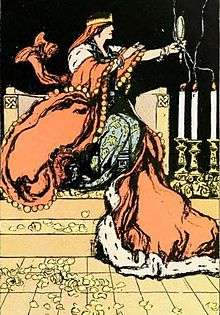 The evil stepmother and queen
The evil stepmother and queen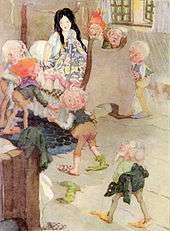 Snow White by Anne Anderson
Snow White by Anne Anderson.jpg) Snow White, c. 1919
Snow White, c. 1919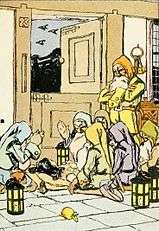 Snow White found by the dwarfs
Snow White found by the dwarfs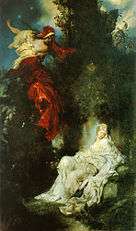 Snow White sleeping, by Hans Makart
Snow White sleeping, by Hans Makart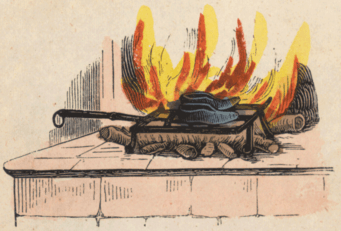 Snow White Iron Shoes
Snow White Iron Shoes.jpg)
Religious interpretation
Erin Heys'[28] "Religious Symbols" article at the website Religion & Snow White analyzes the use of numerous symbols in the story, their implications, and their Christian interpretations, such as the colours red, white, and black; the apple; the number seven; and resurrection.[29]
See also
- List of Disney animated films based on fairy tales
- Margaretha von Waldeck
- Snežana, a Slavic female name meaning "snow woman" with a similar connotation to "Snow White"
- Snow White and the Seven Dwarfs (1937 film), first Disney film.
- Snow white salad
- Snow-White-Fire-Red, an Italian fairy tale
- Udea and her Seven Brothers
- Gold-Tree and Silver-Tree
- The Glass Coffin
- Sleeping Beauty
References
- 1 2 3 4 5 6 7 8 Jacob Grimm & Wilhelm Grimm: Kinder- und Hausmärchen; Band 1, 7. Ausgabe (children's and households fairy tales, volume 1, 7th edition). Dietrich, Göttingen 1857, page 264–273.
- ↑ Jacob Grimm; Wilhelm Grimm (2014-10-19). "The Original Folk and Fairy Tales of the Brothers Grimm: The Complete First ..." Books.google.co.in. Retrieved 2016-04-05.
- ↑ Bartels, Karlheinz (2012). Schneewittchen – Zur Fabulologie des Spessarts. Geschichts- und Museumsverein Lohr a. Main, Lohr a. Main. pp. 56–59. ISBN 978-3-934128-40-8.
- ↑ Heidi Anne Heiner. "Tales Similar to Snow White and the 7 Dwarfs". Retrieved 22 September 2010.
- 1 2 3 4 5 6 English translation of the original
- ↑ Sander, Eckhard (1994). Schneewittchen: Marchen oder Wahrheit? : ein lokaler Bezug zum Kellerwald.
- ↑ Ovid, Metamorphoses, Book XI, 289
- ↑ Anderson, Graham (2000). Fairytale in the ancient world. Routledge. ISBN 978-0-415-23702-4. Retrieved 4 May 2017.
- ↑ Bartels, Karlheinz (2012). Schneewittchen – Zur Fabulologie des Spessarts. Geschichts- und Museumsverein Lohr a. Main, Lohr a. Main; second edition. ISBN 978-3-934128-40-8.
- ↑ Vorwerk, Wolfgang (2015). Das ‘Lohrer Schneewittchen’ – Zur Fabulologie eines Märchens. Ein Beitrag zu: Christian Grandl/ Kevin J.McKenna, (eds.) Bis dat, qui cito dat. Gegengabe in Paremiology, Folklore, Language, and Literature. Honoring Wolfgang Mieder on His Seventieth Birthday. Peter Lang Frankfurt am Main, Bern, Bruxelles, New York, Oxford, Warszawa, Wien. pp. 491–503. ISBN 978-3-631-64872-8.
- ↑ Loibl, Werner (2016). Der Vater der fürstbischöflichen Erthals - Philipp Christoph von und zu Erthal (1689-1748). Geschichts- und Kunstverein Aschaffenburg e.V., Aschaffenburg 2016. ISBN 978-3-87965-126-9.
- ↑ Loibl, Werner (2012). Die kurmainzische Spiegelmanufaktur Lohr am Main (1698–1806). Geschichts- und Kunstverein Aschaffenburg, Aschaffenburg 2012. ISBN 978-3-87965-116-0. ISBN 978-3-87965-117-7
- ↑ Ernst Böklen, Schneewittchenstudien: Erster Teil, Fünfundsiebzig Varianten im ergen Sinn (Leipzig: J. C. Hinrichs, 1910).
- ↑ Steven Swann Jones, ‘The Structure of Snow White’, Fabula, 24 (1983), 56–71, reprinted and slightly expanded in Fairy Tales and Society: Illusion, Allusion, and Paradigm, ed. by Ruth B. Bottigheimer (Philadelphia: University of Philadelphia Press, 1986), pp. 165–84. The material is also repeated in a different context in his The New Comparative Method: Structural and Symbolic Analysis of the Allomotifs of Snow White (Helsinki: Academia Scientiarum Fennica, 1990).
- ↑ Kay Stone, "Three Transformations of Snow White" pp 57-58 James M. McGlathery, ed. The Brothers Grimm and Folktale, ISBN 0-252-01549-5
- ↑ Maria Tatar, The Hard Facts of the Grimms' Fairy Tales, p 36, ISBN 0-691-06722-8
- ↑ Grimm's Complete Fairy Tales, p 194, ISBN 978-1-60710-313-4
- ↑ Hahn, Johann Georg von (1864). Griechische und albanesische Märchen,, Volume 2, "Schneewittchen". W. Engelmann, Leipzig. pp. 134–143.
- ↑ "The Jealous Sisters - Albanian Literature | Folktales". Albanian Literature. Retrieved 2016-04-05.
- ↑ Adapted by Amy Friedman and Meredith Johnson (2 June 2013). "Nourie Hadig (an Armenian folktale)". Uclick. Retrieved 28 January 2015.
- ↑ Orr, Christopher (2012-06-01). "'Snow White and the Huntsman': The Visuals Dazzle, the Performances Don't". The Atlantic. Retrieved 2013-06-04.
- ↑ Pushkin, Alexander (1974). The Tale of the Dead Princess and the Seven Knights. Raduga Publishers.
- ↑ "Update: Relativity Confirms Julia Roberts In Snow White Pic". Deadline.com.
- ↑ Breznican, Anthony (2011-03-26). "Armie Hammer cast as prince in 'Snow White'". Entertainment Weekly. Retrieved 2011-03-28.
- ↑ Anne Sexton. "Transformations". Books.google.com. Retrieved 2016-04-05.
- ↑ "Helen Oyeyemi's 'Boy, Snow, Bird' turns a fairy tale inside out". LA Times. 2014-02-27. Retrieved 2016-04-05.
- ↑ "US Patent and Trademark Office – Snow White trademark status". Retrieved June 28, 2013.
- ↑ Heys, Erin. "Home". Religion & Snow White. Archived from the original on October 23, 2014.
- ↑ Heys, Erin. "Religious Symbols". Religion & Snow White. Archived from the original on October 28, 2014.
Further reading
- Grimm, Jacob and Wilhelm & Applebaum, Stanley (Editor and Translator). Selected Folktales/Ausgewählte Märchen: A Dual-Language Book. Mineola, New York: Dover Publications, Inc. ISBN 0-486-42474-X.
- Jones, Steven Swann (1990). The New Comparative Method: Structural and Symbolic Analysis of the allomotifs of 'Snow White'. Helsinki: FFC., N 247.
External links


- Text of "Little Snow-white" from "Household Tales by Brothers Grimm" on Project Gutenberg